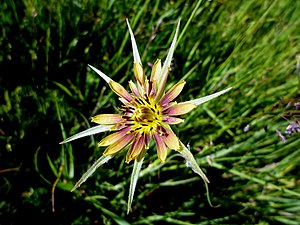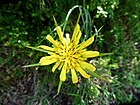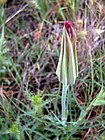Note: This is a project under development. The articles on this wiki are just being initiated and broadly incomplete. You can Help creating new pages.
Difference between revisions of "Tragopogon porrifolius"
(→References) |
|||
| Line 1: | Line 1: | ||
[[File:TRAGOPOGON PORRIFOLIUS - MUNTANYA D'ALINYÀ - IB-309.JPG|thumb|right|''Tragopogon porrifolius'']] | [[File:TRAGOPOGON PORRIFOLIUS - MUNTANYA D'ALINYÀ - IB-309.JPG|thumb|right|''Tragopogon porrifolius'']] | ||
| + | '''Tragopogon porrifolius''' is a Biennial up to 0.60 metres tall. It is harvested from the wild for local use as a food and medicine. | ||
==Uses== | ==Uses== | ||
| − | {{Uses|}}, {{Uses|}}, {{Uses|}}, {{Uses|}}, {{Uses|}}, {{Uses| | + | {{Uses|Liver problems}}, {{Uses|Gallbladder problems}}, {{Uses|Obstructions}}, {{Uses|Jaundice}}, {{Uses|Arteriosclerosis}}, {{Uses|High blood pressure}}.<ref name="Uses"/> |
==Parts Used== | ==Parts Used== | ||
| − | {{Parts Used|}}, {{Parts Used| | + | {{Parts Used|Roots}}, {{Parts Used|Flowers}}, {{Parts Used|Flowering shoots}}. |
==Chemical Composition== | ==Chemical Composition== | ||
| − | <ref name="chemical composition"/> | + | The phytochemical investigation of the aerial parts of Tragopogon porrifolius L. yielded two known caffeic acid derivatives: chlorogenic acid etc.<ref name="chemical composition"/> |
==Common names== | ==Common names== | ||
| Line 28: | Line 29: | ||
==Habit== | ==Habit== | ||
| − | {{Habit|}} | + | {{Habit|Biennial}} |
==Identification== | ==Identification== | ||
| Line 47: | Line 48: | ||
==Mode of Propagation== | ==Mode of Propagation== | ||
| − | {{Propagation|}} | + | {{Propagation|Seeds}} |
==How to plant/cultivate== | ==How to plant/cultivate== | ||
| − | <ref name="How to plant/cultivate"/> | + | Succeeds in ordinary garden soils, including heavy clays.<ref name="How to plant/cultivate"/> |
==Commonly seen growing in areas== | ==Commonly seen growing in areas== | ||
| − | {{Commonly seen|}}, {{Commonly seen| | + | {{Commonly seen|Found near the sea}}, {{Commonly seen|Found near the estuaries}}. |
==Photo Gallery== | ==Photo Gallery== | ||
| Line 69: | Line 70: | ||
<references> | <references> | ||
| − | <ref name="chemical composition">[Chemical constituents]</ref> | + | <ref name="chemical composition">[https://www.researchgate.net/profile/Christian_Zidorn/publication/275329670_Chemical_constituents_of_Tragopogon_porrifolius_L/links/553769990cf268fd00189c07/Chemical-constituents-of-Tragopogon-porrifolius-L.pdf Chemical constituents]</ref> |
<ref name="Leaf">[Morphology]</ref> | <ref name="Leaf">[Morphology]</ref> | ||
| − | <ref name="How to plant/cultivate">[Cultivation]</ref> | + | <ref name="How to plant/cultivate">[http://temperate.theferns.info/plant/Tragopogon+porrifolius Cultivation]</ref> |
<ref name="Uses">Indian Medicinal Plants by C.P.Khare</ref> | <ref name="Uses">Indian Medicinal Plants by C.P.Khare</ref> | ||
</references> | </references> | ||
==External Links== | ==External Links== | ||
| − | * [ ] | + | * [https://pfaf.org/user/plant.aspx?LatinName=Tragopogon+porrifolius Tragopogon porrifolius on pfaf.org] |
| − | * [ ] | + | * [https://www.gardenersworld.com/plants/tragopogon-porrifolius/ Tragopogon porrifolius on gardenersworld.com] |
| − | + | ||
[[Category:Herbs]] | [[Category:Herbs]] | ||
Latest revision as of 16:39, 25 August 2020
Tragopogon porrifolius is a Biennial up to 0.60 metres tall. It is harvested from the wild for local use as a food and medicine.
Contents
- 1 Uses
- 2 Parts Used
- 3 Chemical Composition
- 4 Common names
- 5 Properties
- 6 Habit
- 7 Identification
- 8 List of Ayurvedic medicine in which the herb is used
- 9 Where to get the saplings
- 10 Mode of Propagation
- 11 How to plant/cultivate
- 12 Commonly seen growing in areas
- 13 Photo Gallery
- 14 References
- 15 External Links
Uses
Liver problems, Gallbladder problems, Obstructions, Jaundice, Arteriosclerosis, High blood pressure.[1]
Parts Used
Roots, Flowers, Flowering shoots.
Chemical Composition
The phytochemical investigation of the aerial parts of Tragopogon porrifolius L. yielded two known caffeic acid derivatives: chlorogenic acid etc.[2]
Common names
| Language | Common name |
|---|---|
| Kannada | |
| Hindi | |
| Malayalam | |
| Tamil | |
| Telugu | |
| Marathi | |
| Gujarathi | |
| Punjabi | |
| Kashmiri | |
| Sanskrit | |
| English |
Properties
Reference: Dravya - Substance, Rasa - Taste, Guna - Qualities, Veerya - Potency, Vipaka - Post-digesion effect, Karma - Pharmacological activity, Prabhava - Therepeutics.
Dravya
Rasa
Guna
Veerya
Vipaka
Karma
Prabhava
Habit
Identification
Leaf
| Kind | Shape | Feature |
|---|---|---|
Flower
| Type | Size | Color and composition | Stamen | More information |
|---|---|---|---|---|
| {{{5}}} |
Fruit
| Type | Size | Mass | Appearance | Seeds | More information |
|---|---|---|---|---|---|
Other features
List of Ayurvedic medicine in which the herb is used
Where to get the saplings
Mode of Propagation
How to plant/cultivate
Succeeds in ordinary garden soils, including heavy clays.[4]
Commonly seen growing in areas
Found near the sea, Found near the estuaries.
Photo Gallery
References
- ↑ Indian Medicinal Plants by C.P.Khare
- ↑ Chemical constituents
- ↑ [Morphology]
- ↑ Cultivation
External Links
- Ayurvedic Herbs known to be helpful to treat Liver problems
- Ayurvedic Herbs known to be helpful to treat Gallbladder problems
- Ayurvedic Herbs known to be helpful to treat Obstructions
- Ayurvedic Herbs known to be helpful to treat Jaundice
- Ayurvedic Herbs known to be helpful to treat Arteriosclerosis
- Ayurvedic Herbs known to be helpful to treat High blood pressure
- Herbs with Roots used in medicine
- Herbs with Flowers used in medicine
- Herbs with Flowering shoots used in medicine
- Habit - Biennial
- Index of Plants which can be propagated by Seeds
- Herbs that are commonly seen in the region of Found near the sea
- Herbs that are commonly seen in the region of Found near the estuaries
- Herbs







